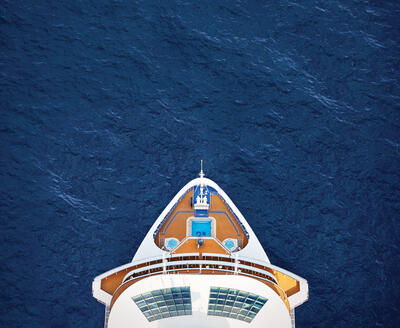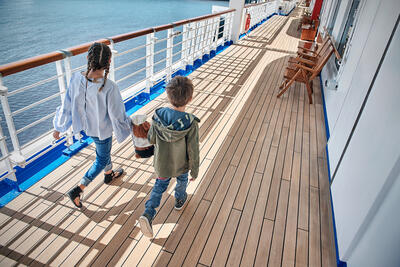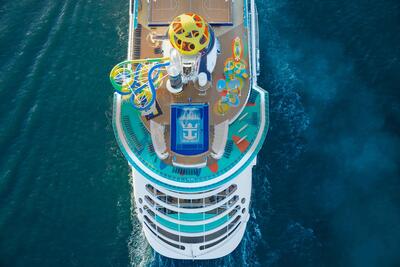No matter how many times you cruise, boarding a new-to-you ship for the first time can be confusing. Cabin hallways can look the same, dead ends can force you to retrace your steps to get to dinner, and if we had a penny for every time we found ourselves at the back of the vessel when we thought we were headed to the front, we could buy a ship of our own.
The first step to orienting yourself is to understand the directional terms that will be used at sea. What does forward mean on a cruise ship? What does aft mean? What's the difference between bow and stern? How about port and starboard?
Below, we will break it down and give you a couple of tips for remembering them when the time comes.

Bow vs. Stern
In order to understand the other terms, it is important to start with bow and stern, which are both physical pieces of a vessel. The bow is a moving ship's frontmost part, which is often made of steel that comes to a point to more efficiently glide through the water. Conversely, the stern is the rearmost part of a ship and is opposite of the bow.
Tip: Remember that you lean to the front when you take a bow.
What is a bulbous bow?
Not to be confused with the bow, the bulbous bow is the bulb-like protrusion found on the front of most modern ships, just below the waterline. Its function is to assist in parting the water, thereby making vessels more efficient as they sail.
Forward vs. Aft

Forward and aft, although similar to bow and stern, are directional terms, rather than words for physical parts of the ship. In that vein, the bow is located forward (to the front) on a ship, and the stern is located aft (to the back).
The aft of the ship is where you will find beautiful wake views while sailing through the ocean on a sea day.
Moreover, the forward of the ship is where you will find the ship's bridge. This is where captain and other crew members carry out navigational duties. If you would like to get a peak into these quarters, you might be able to book a behind-the-scenes tour on your next cruise.
Read more: Take a look inside a cruise ship captain's living quarters
Tip: It's a bit uncouth, but "aft" sounds a lot like "ass," which is your rear.
Port vs. Starboard

Port and starboard, like forward and aft, are directional terms used to indicate a vessel's left and right sides, relative to its bow. When you are facing forward, toward the bow, the port side is to your left, and the starboard side is to your right.
When returning to your stateroom at night, there will often be signs indicating which staterooms are on the port side and which are on the starboard side.
According to the National Oceanic and Atmospheric Administration's National Ocean Service, the terms port and starboard are used instead of left and right because they are always fixed, as relates to the ship's bow. The terms left and right are arbitrary because they can change according to where a person on a vessel is located or which way he or she is facing.
Tip: "Port" and "left" both have four letters.
In addition to helping you to navigate your way to the theater for the nightly show or to the pool bar for a fruity drink with one of those little umbrellas, knowing how to make your way through your ship is also essential during an emergency.
Muster-worthy emergencies are rare, but in the event that you need to find your muster station or assigned lifeboat, knowing the terms in this article is crucial.





